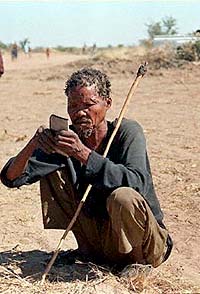| . |  |
. |
 Safari 2000 Seeks To Understand African Ecosystems
Safari 2000 Seeks To Understand African EcosystemsGreenbelt - March 2, 2000 - A caravan of scientists and students begins a 600-mile trek across southern Africa this week as part of a major international experiment to better understand the region's diverse ecosystems and improve NASA's ability to monitor global change around the world. The research caravan is part of a three-year study of southern Africa's ecology, air quality and land use from the ground, air and space. Safari 2000, the Southern African Regional Science Initiative, brings together African, U.S. and international scientists in a multidisciplinary research effort aimed at understanding the sustainability of the region's sensitive and pressured ecosystems. NASA's contribution includes images from the Terra, Landsat 7 and SeaWiFS spacecraft, aircraft measurements, measurements from observation towers, ozone-measuring balloons, and collaborative research with African scientists. Dr. Jeffrey Privette of NASA Goddard Space Flight Center's Laboratory for Terrestrial Physics is one of the coordinators of the 30-person caravan, which began its first survey Feb. 28 in Mongu, Zambia, at the peak of the wet season. Researchers will travel to five different ecosystems along a north-south route from Mongu to Tshane, Botswana. This area, dubbed the "Kalahari Transect" for the underlying sandy soil, has been identified as a key global change study area by the International Geosphere-Biosphere Program. At each survey site, participants will stake out a large, square plot over half a mile (1 kilometer) on a side and inventory the type, density and height of all the vegetation. They will also measure the way sunlight is absorbed and reflected by the plants and soil. By comparing this information with spacecraft views of the same area, scientists can precisely match the reflected sunlight the spacecraft instruments see with the type of ground cover that produces it. This "validation" procedure will increase the precision and usefulness of observations made by NASA's Terra spacecraft, which was launched in December 1999. Terra is scheduled to begin its first observations during Safari 2000. "The caravan survey will produce the first coordinated measurements of several very different ecosystems, from woodlands in the north to shrubland in the south," says Privette. These data combined with chemical analysis of rainfall and atmospheric particles will shed light on how the nutrient-poor soil in this region can support vegetation. One current hypothesis is that nutrients lofted into the air by extensive fires are blown here by winds and deposited in the soil. A final caravan sets off from Mongu early next year heading east to survey the Miombo Forest region. Ozone in the lower atmosphere also will be monitored during this period with balloon-borne instruments launched several times a week. Dr. Anne Thompson of Goddard's Laboratory for Atmospheres is organizing these "ozonesonde" releases from the South African Weather Bureau station in Pretoria. The measurements will be used to validate spacecraft views of lower-atmosphere ozone produced by NASA's Total Ozone Mapping Spectrometer (TOMS).
The cumulative Safari 2000 observations will benefit monitoring of global change worldwide through its use in validating Terra data, says Dr. Michael D. King, senior project scientist of NASA's Earth Observing System Project Science Office at NASA Goddard. "With Safari 2000, we will be able to focus validation of all five Terra scientific instruments with the extensive observations gathered on the ground and in the air. This will help us improve all types of observations Terra will make, from clouds to vegetation types to carbon monoxide." Safari 2000 builds on ongoing research by the international community and southern African nations and on a history of international collaboration in the region. The first Safari field campaign in 1992 produced insights into biomass burning and the long-range movement of air pollution. Safari 2000 pulls together a wider range of scientific disciplines needed to study the functioning of southern African ecosystems and the regional atmosphere. In 1998 President Clinton announced the "Southern Africa Environmental Review" during his trip to Africa in response to the increasing pressures on the environment caused by the rapid growth in population and economic activity in the region. Safari 2000 will support this initiative by providing an enhanced understanding of change in the region. NASA's Earth Observing System project, a suite of spacecraft and interdisciplinary science investigations dedicated to advancing our knowledge of global change, is the primary sponsor of U.S. participants. The Safari 2000 campaign includes international participation from the Republic of South Africa, Zambia, Botswana and Namibia and also includes potential over-flights of Lesotho, Malawi, Mozambique, Swaziland and Zimbabwe.
Read On For A Climatic Week At SpaceDaily
Related Sites This Article
|
| |||||||||
| The content herein, unless otherwise known to be public domain, are Copyright 1995-2016 - Space Media Network. All websites are published in Australia and are solely subject to Australian law and governed by Fair Use principals for news reporting and research purposes. AFP, UPI and IANS news wire stories are copyright Agence France-Presse, United Press International and Indo-Asia News Service. ESA news reports are copyright European Space Agency. All NASA sourced material is public domain. Additional copyrights may apply in whole or part to other bona fide parties. Advertising does not imply endorsement, agreement or approval of any opinions, statements or information provided by Space Media Network on any Web page published or hosted by Space Media Network. Privacy Statement All images and articles appearing on Space Media Network have been edited or digitally altered in some way. Any requests to remove copyright material will be acted upon in a timely and appropriate manner. Any attempt to extort money from Space Media Network will be ignored and reported to Australian Law Enforcement Agencies as a potential case of financial fraud involving the use of a telephonic carriage device or postal service. |